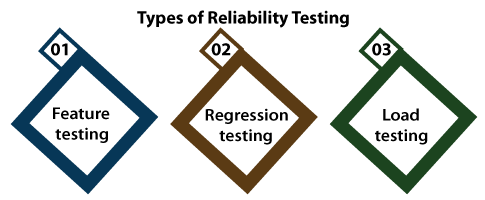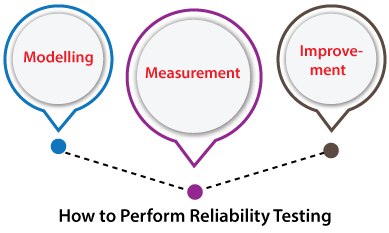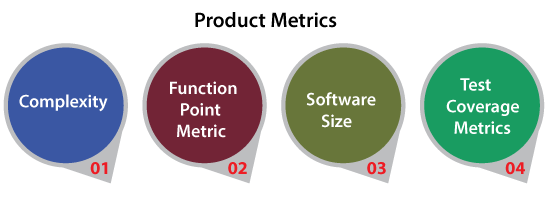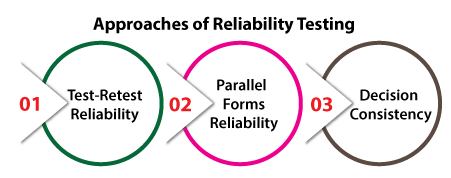While developing a software or an application, there are several characteristics and aspects of the software, authenticated by the software engineers.
To deliver a quality product to the end-users is one of the essential features of software reliability that is tested and verified by the team with the help of the assistance of reliability testing.
In this section, we are going to explore and discuss the following topics related to reliability testing, which help us understand the necessity of reliability testing and product consistency in software testing.
- What is Reliability Testing?
- The goal of Reliability Testing
- Characteristics of Reliability Testing
- Types of Reliability Testing
- Approaches of reliability testing
Before going deep into all the above mention topics, firstly, we will understand the definition of reliability testing.
What is Reliability Testing?
Another essential software testing technique is reliability testing. The team implements reliability testing to guarantee the software or an application is performing and functioning reliably in each environmental condition with a particular period.
The implementation of reliability testing makes sure that the software product is defect-free and reliable for its planned objective.
In simple words, we can say that it verifies whether the software can achieve a failure-free operation for a specific period in a technological environment or not.
In general terms, Reliability signifies yielding the same; in other words, reliable means something is dependable, and both will provide the same outcome each time. And the same is true in the case of Reliability testing.
Reliability is described as the probability of defect-free software operation for a particular time in a specific environment. Mainly it is implemented to guarantee that the software is consistent.
The end-users think that the data shown is correct, and the software will continuously operate appropriately. In the above situations, the need for reliability testing comes into the illustration.
The function of defining that the system has been thoroughly verified and tested is the true meaning of software reliability.
The purpose of Reliability Testing
Following are some of the important objective of performing the reliability testing:
- To test the working of software under a specific condition is the significant purpose of Reliability testing.
- The purpose of executing the reliability testing is to determine the number of defects in the specific period.
- To determine the perceptual structure of monotonous breakdown.
- To find the nasty presence of the software.
- To identify the leading cause of failure.
Characterises of Reliability Testing
Some of the significance of reliability testing which can further understand with the assistance of its various features are as discussed below:
- The reliability testing guarantee that the software meets the client's along with customer's reliability necessities.
- It ensures that the software is performing without any faults and is working as per its planned determination.
- It can be described as the ability of the software to work precisely under the detailed conditions.
- It is a significant surface of reliability engineering programs.
- The data is collected from several phases of software development at the time of reliability testing.
- Before the product is delivered to the end-users, reliability testing helps us to identify defects and faults in the software product.
- It is executed at several software development levels to enhance the reliability and dependability of the product.
Types of Reliability Testing
In software testing, reliability testing categorizes into three types which are discussed as below:
- Feature Testing
- Regression Testing
- Load Testing

Feature Testing
The first type of reliability testing is feature testing. The feature testing concludes the suitability, which implies that it checks if it executes as expected for its intended use.
The main objective of feature testing is to test the attribute and the functionality of the software product, the correctness of the system and to verify if there are no defects identified throughout the beta testing.
In fulfilment of this testing, we will check if the application follows specific criteria such as standards, rules, etc.
Some of the below characteristics are checked during the execution of feature testing:
- All function needs to be done at least once by the team.
- Each function must implement completely.
- The team should also check the proper implementation of each operation.
- The communication between two or more function have to be reduced.
Note: Apart from this, the feature testing verifies some security and compliance. As we already understand, security testing is related to the inhibition of illegal access to the application, either purposely or accidentally.
Regression Testing
Another part of reliability testing is Regression testing. The regression testing is mainly used to check whether any new bugs or defects have been declared because of earlier bugs' fixing.
In simple words, we can say that the Regression testing can be implemented on a new build when there is an essential change in the original functionality.
The implementation of regression testing guarantees that the code still works even when the changes are happening.
Regression means Re-test those parts of the application, which are unchanged.
In regression testing, verification of software quality and the new component's accuracy added to the software product. And the identification of bugs or defects that are generated in the system after the execution of changes.
Note: Regression testing is always executed when a new version or updating of software is built.
For more information about regression testing, refers to the following link:
https://www.javatpoint.com/regression-testing.
Load Testing
The next type of Reliability testing is Load testing. This test is concluded to confirm the functionality of the software under the circumstances of maximum workload.
Load testing is testing where we check an application's performance by applying some load, which is either less than or equal to the desired load.
In load testing, the term load implies that when N-number of users using the application simultaneously or sending the request to the server at a time.
This type of testing will help us to detect an application's maximum operating capacity and any blockages or bottlenecks.
For more information about load testing, refers to the following link:
https://www.javatpoint.com/load-testing.
How to evaluate the Reliability Testing
The reliability testing can be evaluated in terms of Mean time between failures (MTBF).
- Mean Time Between Failures (MTBF):
The MTBF is combines Mean time to failure (MTTF) and Mean time to Repair (MTTR).
MTBF = MTTF + MTTR
Here,
- Mean Time To Failure (MTTF)
The mean time to failure (MTTF) is the time between two consecutive failures. - Mean Time To Repair (MTTR)
Mean time to repair (MTTR) is the time taken to fix the failures.
How to Perform Reliability Testing
To perform any software testing, we need proper planning and management. The execution of Reliability Testing is a bit costlier as compared to other types of software testing.
The implementation of reliability testing includes data for the test environment, test schedule, test points, etc.
The test engineer has to retain the following aspects in order to start the implementation of reliability testing:
- The test engineer needs to use the test results to drive decisions.
- They need to determine the reliability goals.
- They need to plan and execute tests.
- The test engineer needs to cultivate the effective profile.
The reliability testing contains some essential constraints, which are as follows:
- Measurement of time of bug-free operation.
- Possibility of bug-free operation.
- The environment in which it is performed.
The analysis of reliability testing can be divided into three parts, which are as discussed below:
- Modelling
- Measurement
- Improvement

For our better understanding, let us discuss them one by one in details:
Part1: Modelling
We can achieve a meaningful outcome by applying suitable models. In reliability testing, the Software Modelling Technique can be divided into two subcategories, which are as below:
- Prediction Modelling
- Estimation Modelling
The prediction modelling and estimation modelling have some significant differences, which we understand from the below table:
|
Issues |
Prediction Models |
Estimation Models |
|
When
used in Development Cycle |
Generally,
the prediction model is developed before the development or testing stages. |
Generally,
the estimation models are developed at the later stage of the Software
Development Life Cycle (SDLC). |
|
Data
Reference |
The
prediction models use historical data. |
The
estimation models use existing data from software development. |
|
Time
Frame |
Prediction
models will predict consistency in the future. |
The
estimation models will predict the reliability for both the present time or
in the future time. |
Part2: Measurement
In software testing, we cannot directly measure the Software
reliability. Therefore, some other connected aspects are considered in order to
evaluate the software reliability.
- Product Metrics
- Fault and Failure Metrics
- Process Metrics
- Project Management Metrics

Let see a detailed information of the software reliability measurement parts:
1. Product Metrics
The Product metrics is the first part of software reliability measurement, which are the combination of four different types of metrics:

- Complexity
- Function point Metric
- Software size
- Test Coverage Metrics
Complexity
- The representation of complexity is significant as it is directly related to software reliability.
- It is a process of defining a program's control structure's difficulty by simplifying the code into a graphical illustration.
Function point Metric
- Another metric that comes under the product metric is the Function point Metric, which is mainly used for determining the functionality of Software Development.
- The function point metric will take the count of inputs, outputs, master files, etc.
- It calculates those components which are delivered to the user and is independent of the programming language.
Software size
- The next part of the product metric is software size. In this Metric, we can use the Line of Code (LOC) for measuring the size of the software as it is an in-built initial approach.
Test Coverage Metrics
- The test coverage metrics approximate the fault and reliability by implementing the full test of software products.
2. Fault and Failure Metrics
In fault and failure metrics, we used to check whether the system is entirely bug-free or not. Both the types of faults were identified at the time of the testing process, which means before delivering the product.
And to accomplish the objective, we need to check and summarized the failure reported by users after delivery.
3. Process Metrics
The process metrics are used to evaluate, display, and enhance the software's reliability and quality. As we already knew that the quality of the product is directly related to the process.
4. Project Management Metrics
The last part of software reliability measurement is project management metrics. We know that good management can accomplish advanced reliability by using a better risk management process, development process, configuration management process, etc.
Part 3: Improvement
The next part of software reliability testing is Improvement. The Improvement is entirely depending upon the difficulties that happened in the application or system or the software features.
The method of Improvement will also vary as per the complexity of the software module. The time and budget are the two main constraints that will limit the attempts are put into the software reliability improvement.
As we know that, so far, there is no good approach to overcome the complexity problem of software.
Approaches of Reliability Testing
In software testing, we will execute the reliability testing to make sure that all the bugs and faults present in the system are detected and fixed by the specified team before deployed to the user site.
Sometimes it is not easy to evaluate the precise reliability. But it can be assessed with the help of several methods. Some of the most commonly used approaches of reliability testing are as discussed below:

- Test-Retest Reliability
- Parallel Forms Reliability
- Decision Consistency
Test-Retest Reliability
- The first approach of reliability testing is Test-retest reliability. This type of reliability method explains how a test can give stable, reliable scores within time.
- In order to test the constancy and the reliability of the score, it is performed in a short period. In simple words, we can say that the team tests and reteststhe software over several testing techniques to confirm its reliability and constancy.
Parallel Forms Reliability
- The second method of software reliability testing is parallel forms reliability.
- In this particular approach, the software is tested by two distinct groups to test how equally the two function forms.
- By using this method, the team can validate the reliability of the outcome through several forms.
Decision Consistency
- The last approach of reliability testing is decision consistency.
- In this method, the output from the first two approaches (test-retest reliability and parallel forms reliability) are tested during the decision consistency. And concludes their success and failure.
Overview
In the reliability testing article, we have understood the working of reliability testing, its types, features, different approaches, evaluation of reliability testing, and the process of reliability testing.
After seeing all the topics mentioned above, we can conclude that software reliability is a significant part of software quality.
Comparing Reliability Testing to other types of testing is a bit costlier process as it requires proper test planning and test management.
The execution of reliability testing ensures the development team and clients that the software being established is highly consistent and works in the desired manner. And it doesn't matter whether it is expansive or not.
If we are talking about the software development life cycle, reliability testing plays a significant role. As we discussed above, the usage of reliability standards will bring constancy to the software and forecast the future of the software.
Reliability testing helps to make sure that we are delivering a quality end-product. It helps us to identify and fix bugs, improve performance, and test features.
Repeatedly, if the software has a high complexity, then software reliability is hard to get. And we can guarantee that our software is working exactly how it should be with the implementation of reliability testing.



0 Comments